Most gas ranges currently available employ one of 3 basic gas ignition systems; pilot ignition, hot surface ignition system (which uses a 'glow bar' or 'glow coil' - aka an "ignitor") and a spark ignition system. The latter two being referred to as "electronic ignition" systems as they use electricity in one form or another to operate the oven heating system. Only the pilot ignition system has an actual "pilot" (which is a small but real "flame") which might need manual lighting. 
The oven bake burner and ignition components are located beneath the oven cavity. In most cases the oven bottom panel can be removed for access (check your owner's manual) but on some models the oven burner has to be accessed from below in the warming or broiler drawer area. If accessing from the top, a 'flame spreader' (flat metal plate) above the burner may also need to be removed to see the burner itself.
Some range models may have an additional broil burner located at the top of the oven cavity which may be referred to as a 'waist high' broil. If not, broiling usually takes place in the drawer area below the oven, which uses the same bake burner for the broil function.
Whirlpool DSI Ignition System
Pilot Ignition System 
On a pilot ignition oven, there is a pilot which is an actual gas flame (although very small) in the oven. What happens in this system is that the pilot stays lit all the time and when the oven thermostat is turned on, the pilot flame extends (gets bigger) to envelope the thermocouple bulb of the oven safety valve. The thermostat controls gas flow to both the pilot and to the oven safety valve. Once the oven safety valve's thermocouple senses appropriate heat, the safety valve opens to allow gas flow to the oven burner where the pilot flame ignites the gas.
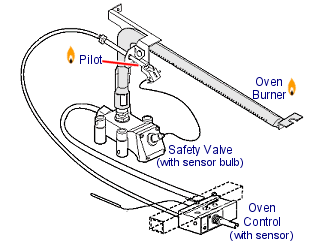
The main oven burner should usually light in less than 1-1½ minutes after the pilot flame has extended to envelope the safety valve's thermocouple.
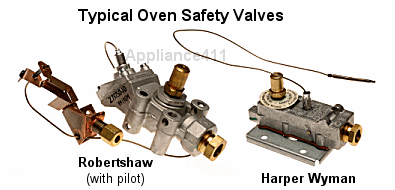
Oven not heating
On a pilot ignition system the pilot flame must be lit for the oven burner to receive gas. If the pilot will not stay lit, there may be a problem in the oven thermostat (which supplies gas flow to the pilot) or the gas tubing leading to it and/or the pilot itself may be plugged with cobwebs, grease, etc.
 Note: On some recent (2004+) Americana, GE, Magic Chef and probably other pilot ignition range models, the oven thermostat knob needs to be pushed in and held before the pilot can be re-lit if it has gone out. The oven control knob may have to continue to be held in for up to a minute after the pilot has been re-lit.
Note: On some recent (2004+) Americana, GE, Magic Chef and probably other pilot ignition range models, the oven thermostat knob needs to be pushed in and held before the pilot can be re-lit if it has gone out. The oven control knob may have to continue to be held in for up to a minute after the pilot has been re-lit.
If the pilot IS lit but the oven burner is not lighting, the pilot flame will need to be inspected as the thermostat is turned on. If the pilot is not extending when the thermostat is tuned to ON, the oven thermostat may be defective. If the pilot is extending but the oven gas valve is not opening, that oven safety valve may be defective or its sensor bulb may be out of position on the pilot or just dirty causing it to not sense the proper temperature of the pilot flame. A dirty pilot can also cause a reduced size pilot flame so the oven safety valve can not sense the proper temperature to open.
Observations necessary to diagnose problems
 Is the pilot lit?
Is the pilot lit?
 Does the pilot extend (get bigger) when the thermostat is turned on?
Does the pilot extend (get bigger) when the thermostat is turned on?
 Is the safety valve's sensor properly mounted in the pilot?
Is the safety valve's sensor properly mounted in the pilot?
Electronic Ignition Systems
Constant Pilot with Flame Switch (rare)
This older type of electronic ignition system was popular in the mid 70's and is for the most part no longer used but ranges/ovens employing it may still be in service. It was a fairly reliable setup.
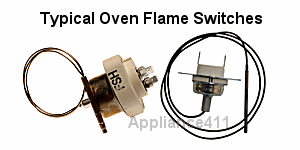
On this style of ignition system there is a constantly burning pilot similar to the pilot ignition system described above but the pilot flame does not change in size as the control is turned on. This system uses a 'flame switch' to detect that the pilot is lit instead of a safety valve like on the pilot ignition system. The thermostat on such a system is just electrical and does not alter gas flow to the oven.
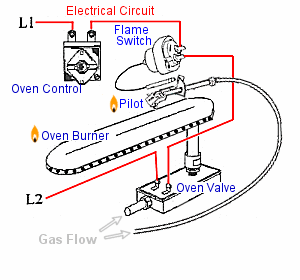
The pilot flame should heat the tip of the flame switch's sensor bulb to a red colour. If the flame switch detects sufficient heat on its sensor bulb at the pilot, it will close an electrical contact in its base. Once the thermostat is turned on, current will be allowed to flow through the flame switch to the oven valve to allow it to open. If the flame switch's sensor is not heated sufficiently, the electrical contacts of the flame switch would remain open preventing any power from reaching the oven valve which in turn would prevent gas from flowing to the oven burner.
In a properly operating system it should usually only take in the area of 30-45 seconds for the oven burner to receive gas and to light.
Oven burner not getting gas
The pilot must be lit before electrical current will flow through the flame switch to the oven gas valve to allow gas to the oven burner. The flame switch's contacts must be closed when its sensor is heated by the pilot. The thermostat's contacts must close when turned on to allow current to flow to the rest of the oven system. A fault in any of those functions will prevent gas from flowing to the oven burner as a safety precaution.
Oven burner getting gas but not lighting
This symptom could be caused by a partially plugged or dirty pilot or plugged gas ports on the burner nearest the pilot flame.
Observations/tests necessary to diagnose problems
 Is the pilot lit?
Is the pilot lit?
 Is the flame switch's sensor properly mounted in the pilot?
Is the flame switch's sensor properly mounted in the pilot?
 Do the thermostat's contacts close (have continuity) when it is turned on?
Do the thermostat's contacts close (have continuity) when it is turned on?
 Do the flame switch's contacts close when its sensor is heated by the pilot?
Do the flame switch's contacts close when its sensor is heated by the pilot?
 Is there continuity between the oven gas valve's terminals?
Is there continuity between the oven gas valve's terminals?
Hot Surface ('Glow Bar') Ignition System  (most common)
(most common)
This is the most popular system currently used for ovens and is comprised of a control mechanism (whether thermostat or electronic control), the oven ignitor and an oven gas valve.
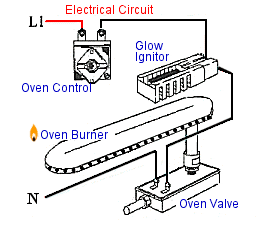
What happens in this style ignition system is that the thermostat or electronic control switches power to the oven ignitor and gas valve circuit which are connected in series (one after the other). As power flows through the ignitor it heats and draws current (measured in amperage). Once the oven ignitor draws a specific amount of current the oven valve opens to allow gas to flow to the oven burner where the glowing hot ignitor (glow bar) ignites it. Power must continually flow through the ignitor and oven gas valve for gas to be released into the oven burner to create a flame. Once the set temperature is achieved the control stops all power to the ignition circuit which causes the ignitor to dim and the oven gas valve to close, stopping any burner flame. Cycling on and off continues to maintain the specific temperature the control is set for.
It should usually only take in the area of 30-90 seconds for the oven ignitor to reach the proper resistance to allow the proper amperage to reach the gas valve to open it and for the ignitor to ignite the gas at the oven burner.
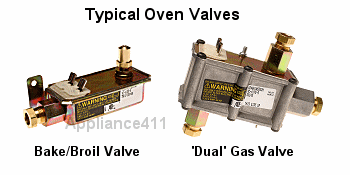
Many ovens use a single oven burner in which case they only have a single gas valve and ignitor. The same burner is used for both bake and broil functions, the broil usually being in the drawer area below the oven. Higher-end models may have a separate bake and broil burner. On such a system there will be two ignitors, one for each burner. They may also employ a 'dual' gas valve (see illustration above) instead of using a separate valve for each burner.
Dual Gas Valve
On oven models utilizing a 'dual' gas valve, both the bake and broil gas and ignition systems should be considered totally independent of each other. Even each side of the dual gas valve should be evaluated as if each side was a separate 'single' gas valve. Just because one side of a dual gas valve might work does NOT mean the other side of the valve should work too. Each is a separate mechanism inside a common housing.
Ignitor glowing but oven not heating
As long at the ignitor is being powered, the control system (hydraulic thermostat or electronic control) is doing its job. The ignitor, while glowing, may not be allowing the proper amount of current to flow through it to the oven gas valve for it to open. Proper testing (see the link at the bottom of the page) requires an ammeter to check the current flow through the ignition circuit to the oven bake/broil valve.
Myth: My oven ignitor is glowing so it must be good.
Weak oven ignitors can glow but not achieve an adequate resistance to allow the correct current to flow to the gas valve for it to open. They can also glow but not be quite hot enough to ignite the gas immediately. See 'Mini-Explosions' below for more on the latter.
Ignitor glowing but oven only gets warm
If the ignitor ages and gets 'weak', it is possible for it to glow and generate some warmth in the oven but the oven burner never actually come on to get the oven up to proper temperature. It is also possible for the oven burner to light and heat once but never cycle back on again afterward. The heat generated by the ignitor may keep the oven warm for a while until it is noticed that the oven isn't heating 'right' any longer.
Oven not heating and ignitor NOT glowing
Power must flow from the control system to the ignitor and through the oven valve. If there is any break in that circuit, the ignitor will not glow and thus the gas valve not open. The ignitor not glowing could be caused by the ignitor or the gas valve being open (infinite resistance - no continuity). If both have continuity (ie. at least some resistance) and the ignitor is still not glowing, a problem in the control system or the rest of the electrical circuit would need to be investigated.
An ignitor and oven valve having continuity does not necessarily that they are good, just that they're not electrically open, which is only one way that they might fail. If either has NO continuity at all (ie. infinite resistance) they are likely defective and need to be replaced.
Gas Smell and/or Mini-Explosions in the Oven
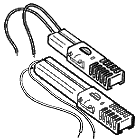 Ignitors do age and will eventually generate less heat than they normally should. When this happens they can still allow marginally correct current to flow to the oven gas valve for it to open but not get quite hot enough to ignite the gas burner immediately. When this occurs, gas released into the oven can result in a gas smell or sometimes even build up to the point where when finally ignited, the extra amount of gas lit can cause a small explosion inside the oven.
Ignitors do age and will eventually generate less heat than they normally should. When this happens they can still allow marginally correct current to flow to the oven gas valve for it to open but not get quite hot enough to ignite the gas burner immediately. When this occurs, gas released into the oven can result in a gas smell or sometimes even build up to the point where when finally ignited, the extra amount of gas lit can cause a small explosion inside the oven.
In the latter case, the oven should be removed from use until the condition can be looked into and corrected. DO NOT continue to use a gas appliance in such a condition!
Pulsating Oven Flame
It can sometimes happen that the ignitor is just on the verge of allowing the correct amperage to the oven valve, but not quite. In such a case the oven valve can repeatedly cycle open and close quickly, creating a 'pulsating' or sputtering burner flame. Testing for proper amperage draw of the ignition circuit is needed to determine if a 'weak' oven ignitor may be responsible instead of an internal problem with the oven valve itself.
Observations/tests necessary to diagnose problems
 Does the ignitor glow when the oven burner should be heating?
Does the ignitor glow when the oven burner should be heating?
If NOT glowing at all:
 Does the oven ignitor have continuity?
Does the oven ignitor have continuity?
 Does the oven valve have continuity between its terminals?
Does the oven valve have continuity between its terminals?
 Is the oven control system providing power to the oven ignition components?
Is the oven control system providing power to the oven ignition components?
If the ignitor IS glowing:
 What is the amperage* draw on the ignition circuit?
What is the amperage* draw on the ignition circuit?
*There is NO voltage or resistance test that will help to diagnose the cause of the problem at this point. Only an amperage test is relevant. An ignitor with a white or beige colored rectangular base should draw 3.2 to 3.6 amps or it is defective. A round base or powder-blue colored rectangular base ignitor should draw 2.5 to 3.0 amps.
Spark Ignition Systems 
Conventional
Oven models using a 'conventional' spark ignition system also have an actual gas pilot like a pilot ignition system but it is not lit all the time.
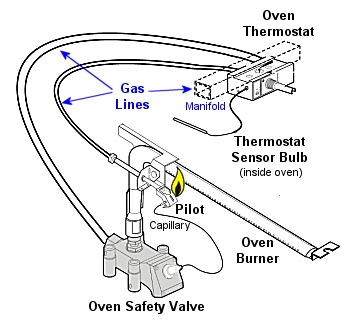
Instead, when the oven thermostat is turned on, gas flows to the oven safety valve and also to the oven's pilot, which gets lit via a spark. Once the pilot is lit and the safety valve's sensor bulb senses that pilot flame, that valve will then open up to allow gas to flow to the oven burner where the pilot flame ignites the burner.
Observations/tests necessary to diagnose problems
 Is the pilot receiving gas when the oven is turned on?
Is the pilot receiving gas when the oven is turned on?
 Is the pilot igniting and staying lit?
Is the pilot igniting and staying lit?
If NOT, can the pilot be lit manually when the thermostat is on?
 Is the oven burner getting gas when the pilot is lit?
Is the oven burner getting gas when the pilot is lit?
Whirlpool Direct Spark Ignition (DSI)
Whirlpool has introduced a new variation on the spark ignition system. In this system there is no 'pilot', instead the spark directly ignites the gas burner (hence the name) and an additional electronic control monitors its performance.
When the range control calls for either bake or broil, the DSI module electronically checks both gas valves' solenoids for continuity. If the checks fail, the module will turn the oven off or lock it out. If the checks are successful, the module will power the appropriate gas valve so it can open and also initiate sparking at the burner ignitor. Both the bake and broil ignitors will spark simultaneously.
If no flame is present at the burner, the DSI module will allow the ignitor to spark for 4 seconds. A 30 second pause will then occur, after which time it will attempt to light the burner again. If gas still fails to ignite, the microcomputer will then lock the system out.
Once gas has ignited, the flame sensing circuitry will monitor the flame at the burner as long as it is powered to make sure that it is present. If at any point no flame is detected, the DSI module will lock out the system.
On such a system the oven will not light for 30 seconds after power is restored to the appliance. Also, if no ground is found in the power connection to the range (or just at the DSI control), the oven will light once but them turn off and be 'locked out'.
Whirlpool's DSI system will likely only be found on Whirlpool's brands of appliances such as Whirlpool, KitchenAid, Roper and Inglis as well as some Whirlpool built Kenmore ranges and ovens.


